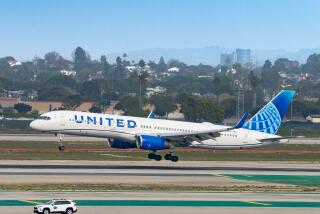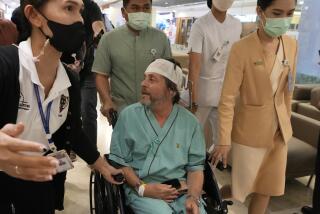On United Airlines flight to LAX, he gave CPR to man dying of COVID-19

It began as normally as a plane flight could during a pandemic.
United Airlines Flight 591, carrying 164 people, took off from Orlando, Fla., on Dec. 14 for a routine 5½-hour ride to Los Angeles.
But as the plane glided over Louisiana, a passenger felt short of breath. Soon, 69-year-old Los Angeles resident Isaias Hernandez was lying in the aisle, unresponsive.
Flight attendants put a call over the intercom, asking whether any doctors or nurses were on board.
Two passengers had already begun to administer CPR when Tony Aldapa, eight rows ahead of Hernandez, offered to help.
Aldapa is a Navy veteran and emergency medical technician who works at a Veterans Affairs medical center in West Los Angeles, so he is well trained in handling a crisis like this.
“Regardless of COVID ... he needed CPR to save his life,” Aldapa, 31, said. “I knew we were pretty far from where we needed to land at, and CPR is exhausting with one person or two people. Even with three or four people, it’s not an easy thing to do.”
The pilots made an emergency landing in New Orleans. Hernandez was sent to a hospital, where he was pronounced dead, according to a United Airlines statement.
At the time, medical professionals told airline officials that he was experiencing cardiac distress, according to United Airlines.
Passengers were given the option to take a later plane to Los Angeles, according to the statement, but all elected to continue on the flight.
At least one person on board suspected why Hernandez had fallen ill. The coroner in Jefferson Parish, La., confirmed that suspicion a week later, listing “acute respiratory failure; COVID-19” as the cause of death.
The in-flight tragedy set off a flurry of questions and finger-pointing. Aldapa has since developed mild COVID-like symptoms, including a headache, fatigue, body aches and a minor cough, though he has tested negative three times.
He said that United called him Sunday but that he hasn’t been contacted by the U.S. Centers for Disease Control and Prevention.
The L.A. County Department of Public Health has not contacted him either, he said. In a statement to The Times, the department declined to comment about its involvement in the investigation and contact-tracing effort, saying only that it “will continue to work with CDC to notify patients as appropriate.”
The CDC did not respond to requests for information.
United said it is sharing information about the incident with the CDC.
“The health and safety of our employees and customers is our highest priority, which is why we have various policies and procedures in place such as mask mandates and requiring customers to complete a ‘Ready-to-Fly’ checklist before the flight acknowledging they have not been diagnosed with COVID-19 in the last 14 days and do not have COVID-related symptoms,” the United Airlines statement said.
Like all United passengers, Hernandez signed the checklist before boarding. But his story underlines that the safety measure isn’t foolproof.
Aldapa doesn’t blame the airline. Even precautions like temperature checks, which have not been implemented, can’t catch every COVID-19 case, he said.
On the plane, Aldapa and the two other passengers took turns doing chest compressions and using a bag valve mask to provide oxygen. There was no mouth-to-mouth resuscitation, he said. The flight crew stood by, offering supplies, including gloves, sanitizer and water.
After a couple of turns doing chest compressions, Aldapa realized he had been sitting next to the man’s wife during his breaks. He struck up a conversation, asking about her husband’s medical history, any recent exposures to COVID-19 and any tests for the virus.
She told him that her husband had been short of breath and that he was planning to get tested when they got home, Aldapa said.
By the time the plane made an emergency landing in New Orleans, a medical device used by the volunteers registered that 47 minutes had gone by since they started CPR, Aldapa said.
Aldapa said he thought about the possibility that he could contract the coronavirus, with his emergency room work preparing him to assume that anyone could have COVID-19.
He said it’s unfortunate that the man who suffered a medical emergency on Flight 591 is being disparaged on social media for having boarded the plane despite possible COVID-19 symptoms.
Still, he said, people are responsible for protecting one another as much as themselves.
“Taking a test isn’t a permission slip to be out there,” he said. “If you’re feeling sick, you have to take that into consideration.”
More to Read
Sign up for Essential California
The most important California stories and recommendations in your inbox every morning.
You may occasionally receive promotional content from the Los Angeles Times.












